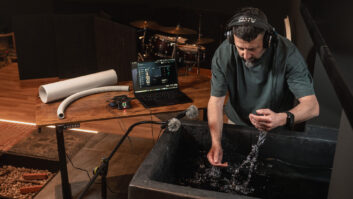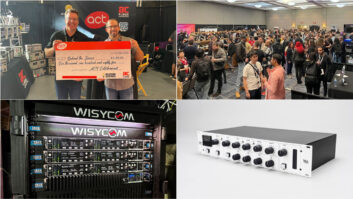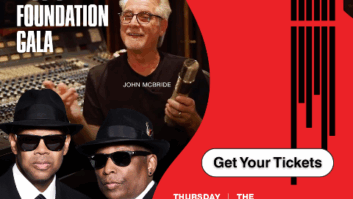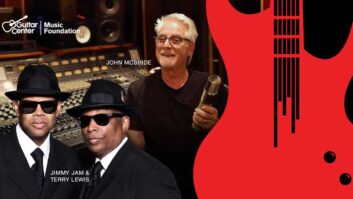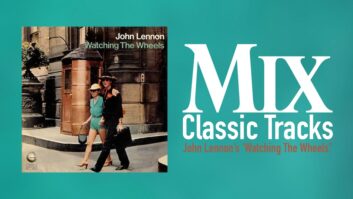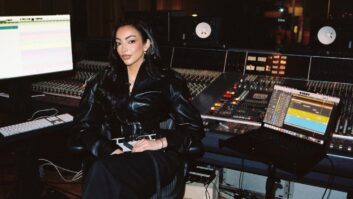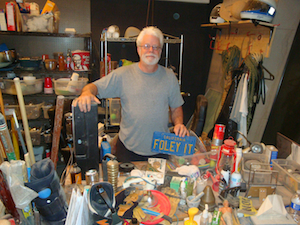
John Roesch is a very noisy man. And he has been for more than 30 years.
A Foley artist on more than 400 motion pictures, Roesch recently received the MPSE’s Career Achievement Award at the 2013 Golden Reel Awards, the first Foley artist so honored. “I guess they felt I had the right stuff,” he says with his usual deadpan, from his home base in Bldg. 68 on the Warner Bros. lot.
“The term ‘Foley’ is a bit of a misnomer,” he starts off. “It doesn’t succinctly say what it is we do. Foley is custom sound effects. We are creating sound exactly as it is seen on the screen. It’s whatever the audience will believe as correct, that matches what we see. If it’s not onscreen, we don’t do it.”
Though he had originally planned on being an actor, Roesch received a degree in filmmaking from New York University in the mid-1970s, followed by a year as a Directing Fellow at AFI in Hollywood. In 1976, as a favor to a friend, now-supervising sound editor Dessie Markovsky, he took on Foley duties for a film. “Of course I helped her, but I thought, ‘Boy, what a stupid job,’” Roesch says. [Laughs.]
On his way to what he thought would be his second—and last—Foley job, he ran into his apartment manager and told her where he was going. Coincidentally, “she” turned out to be award-winning Foley artist Joan Rowe, and she told Roesch they had an opening at Gomillion Sound, where she worked for the late Ted Gomillion. Later, she would become Roesch’s first Foley partner.
At the time, Roesch says, the most a Foley artist was expected to do was provide the basics. “You did some footsteps, to fill the void, and you did some props here and there, and that was really the end of it. But at Gomillion, we were asked to do a lot more just to ‘help out.’”
By 1978, Roesch had gone freelance, working out of the Samuel Goldwyn Studios (soon to become Warner Hollywood), where veteran sound effects editor Doug Grindstaff introduced him to supervising sound editor Gordon Ecker, Jr. “Gordy wanted to do Foley outside ‘the system,’” Roesch recalls. “Not only outside the system, but outside the studio. He would ask us to do things that Foley artists didn’t usually do, which would be breaking the rules at a major studio. I didn’t know that there were any unwritten rules. And even if I knew there were, I don’t know that I would have cared that much, because Foley itself is just so much fun to do.”
Ecker and Roesch, along with mixer Tim Sadler, soon opened Warren Sound West, renting a small dub stage owned by mixer Peter Smolian and developing a new approach to Foley. Sadler would, for instance, suggest microphones not normally used in Foley, such as a Sony ECM-50 lav mic, in order to get closer to the source, making the sounds larger than life. “Gordy taught me that there are no rules in Foley,” Roesch says. “That’s the only rule.”
In the ’80s, Roesch began working with Joan Rowe, his first of several partners (Ellen Heuer, 1991-94; Hilda Hodges, 1995-99; Alyson Moore, present). They were soon called by Oscar-winning supervising sound editor Chuck Campbell. “He was the other great teacher for me,” Roesch says. “Gordy showed me there were no limits, and Chuck really sculpted my sonic ear. Something which I would think was good, he would point out to me what I might try to make it better. And that really has served me well.”
For E.T., Campbell relayed director Steven Spielberg’s request that E.T. sound “funny.” “Joanie and I went to lunch, and somebody ordered Jell-O,” Roesch remembers. “And as the bowl was thrown onto one of our trays, and it was wiggling away, we just looked at each other and started laughing. Joan went home and cooked up a huge pot of Jell-O, and I took my T-shirt and taped the neck and the arms, turned it upside down, and poured all this Jell-O into it.”
Roesch also performed E.T.’s walk: “He reminded me of a duck out of water—the way they’re graceful in their own world, but on land, they waddle around. So I did his footsteps using my hands.” The film won two Oscars for sound, including Best Sound Effects Editing.
By 1984, Roesch and Sadler teamed up with Allan Goodman and opened TAJ Soundworks. There, they welcomed the technological skills of engineer Ed Bannon, who provided, among other things, a custom-made mic cable known as “The Phaser.” Bannon also solved a sound intrusion problem in the ceiling of TAJ’s studio with a custom suspension system, something he also utilized in a mic stand system, which similarly isolated low-frequency sounds. Bannon also suggested using a Neumann KMR 81 shotgun mic, which Roesch immediately found to his liking. “That was, once again, against the ‘Foley law,’ but it allowed me to go off-axis and sound more naturally offstage, if I needed.”
In 1992, the TAJ partners split, and Warner’s sound department head, Don Rogers, invited Roesch to join his studio team, first at Warner Hollywood, and then, in 2000, to his current home base on the lot.
Advances both in filmmaking and directorial skill have meant additional challenges for the Foley artist, Roesch notes. “Some directors that we work with, such as Christopher Nolan or David Fincher, are very precise in what they give us to do. Fincher told Ren Klyce, the supervising sound editor on The Girl with the Dragon Tattoo, that he wanted the town in the film to sound very cold. The first way that was introduced is when Daniel Craig’s character arrives on a train. We wanted the wheels to sound very cold and crackly. So I bought a couple of old ice trays, the ones with the handles, on eBay, so when it pulled up, I would slowly pull the handle in conjunction with the picture.”
The level of precision is challenging, but it’s also the reason Roesch does what he does. “That kind of thing is so much fun for us. It makes our job more difficult, but much more rewarding. An ice tray. It’s fantastic.”
Sidebar: Lasting Effects
Lawrence Kasdan’s western Silverado gave Roesch a chance to help introduce something that would become a hallmark of his work. “Bob Grieve, the supervising sound editor, really wanted the film to give the experience of the expanse of the West, the feeling of being in a saloon,” he explains. “I actually bought some replicas for that film, like of a Henry rifle and a Colt six-shooter. I really want to get as much authenticity in a film as possible.”
But in this case, the literal authenticity was superseded by screen authenticity—specifically the sounds of spent brass shell casings hitting the ground. “The problem was that when we used the caliber of the actual weapon, they all sounded like a dull dink. But if I used something from a large-caliber rifle, like a .223, it sounded right. Now, pretty much any time you hear a bullet casing in any film, that’s what it’s going to be, not the actual caliber.”
